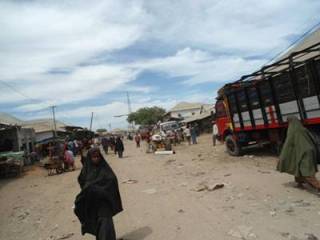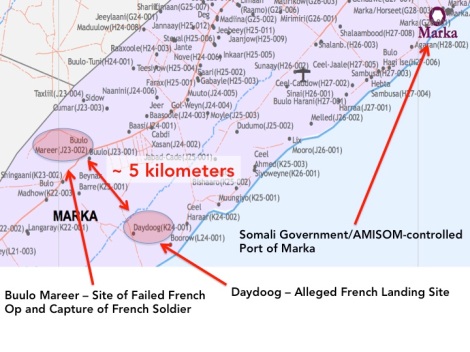The government of Somalia has condemned the French failed rescue operation, saying it was not informed about it.
In the early hours of 12 January 2013, French special forces failed in an operation to rescue French intelligence agent Denis Allex from al-Shabaab in the town of Buulo Mareer.
Buulo Mareer is firmly controlled by al-Shabaab–although Somalia National Army (SNA) and AMISOM forces are 17 mi (28 km) northeast holding the port of Marka.
Allex was intially kidnapped in a Mogadishu hotel in July 2009 with a colleague who later escaped.
Another shocking result from the operation was that a French special forces member injured in the operation was captured and is now in al-Shabaab custody–along with Allex.
Al-Shabaab’s new hostage is another blow to France’s special operations in Africa recently. Only 24 hours earlier, a French pilot was killed in a helicopter crash during operations to push back Islamist militants in northern Mali.
Somalia’s governor for Lower Shabelle region Abdiqadir Nur claimed to know in advance of the operation, but the cabinet of Prime Minister Abdi Farah ‘Shirdon’ reportedly had no such knowledge. Given that the failed mission resulted in the death of several civilians, the operation will surely draw an unhappy response from the Somali government.
The Operation
Initial reports cite witnesses who say French special forces disembarked from a helicopter near an al-Shabaab base in Buulo Mareer and quickly engaged in an intense 45-minute firefight with al-Shabaab militants.
Pro-al-Shabaab site SomaliMemo reported that al-Shabaab used several battle wagons during counter operations. Both sides experienced casualties along with at least 7 civilians who were killed.
In his public address, French Defense Minister Jean-Yves Le Drian said it was “doubtless” that Allex was killed by his captors–though he did not actually confirm this claim.
Al-Shabaab’s official statement contends that Allex is still alive and was moved away from Buulo Mareer. The group said it will determine the fate of the Allex within two days–but it did not mention the potential fortune of the captured French soldier.
There are additional reports that alleged French special forces landed in the town of Daydoog–about 3 mi (5 km) from Buulo Mareer.
Sources claim that French special forces killed several civilians after landing in the town. Survivors were said to have tipped off al-Shabaab officials in Buulo Mareer about the incident before the attack. (It is difficult to verify all the details of these reports.)
Analysis of the Operation
France’s failure to rescue Allex successfully–and its gift to al-Shabaab of another hostage and a victory in the media–can be explained by several factors.
[1] The French potentially did not have good intelligence. It is difficult to retrieve reliable information about atmospherics, the security environment, and the exact location of hostages in denied areas like Somalia’s rural cities. In this case, al-Shabaab claimed that the French attacked the wrong house in its search for Allex–a mistake that would have all but doomed the operation if true.
Even if it is untrue, the speed with which French forces were repelled and the clumsy nature of their retreat (leaving members behind) hints that they underestimated what kind of security they would encounter.
Updated reports say that the 50 French special forces in the operation encountered at least 100 heavily-armed al-Shabaab members, who say they had been tipped off about the attack.
So, it appears an unexpected encounter with civilians outside Buulo Mareer led to al-Shabaab being warned of France’s advance. This would have allowed al-Shabaab to rally core forces, and potentially arm locals, to be ready for the oncoming attack.
This points to a larger gap in France’s intel collection capabilities in the country.
To give a comparison, the U.S. has installed a CIA compound and prison in Somalia’s capital Mogadishu, and has developed an efficiency ability to collect intelligence in Somalia by establishing cozy relationships with Somali intelligence agents. By having “eyes” and “ears” in Somalia, the U.S. has been able to accomplish some feats that far outweigh the failure of Operation Restore Hope in 1993.
Contrastingly, France’s closest and largest concentration of military assets is in neighbouring Djibouti, but this is a long way from the site of its operation to rescue Allex. Additionally, there have not been indications that France has established the ability to collect intel like the U.S. in Somalia.
Lastly, it is unclear in what way American intelligence resources contributed (or did not contribute) to the French operation. But, it’s very possible that France’s comparably fewer resources to collect intelligence in Somalia negatively impacted the rescue.
[2] The French lack experience carrying out special operations on the ground in Somalia. Undoubtedly, carrying out a rescue operation in a small al-Shabaab controlled town is an especially difficult mission–almost a fool’s errand for most foreign forces.
It is also far from the kind of mission that French special forces have perfected.
France has the kind of record in rescue missions that would not inspire total confidence for those held captive with French passports. (See total success against Somali pirates here, partial success against Somali pirates here, and total failure against al-Qai’da in the Islamic Maghreb (AQIM) here.)
Equally important, France’s operations against pirates in the open seas are much different than operations in al-Shabaab controlled towns in the middle of the night when there is [1] potentially inadequate intelligence regarding the hostage’s location and status of local security, [2] unfamiliarity with operating on Somali terrain, and [2] the inevitability of unknown obstacles–such as unanticipated encounters with locals.
[3] France reinforced the view that al-Shabaab is still operationally strong; that France’s ability to lead operations in Africa is questionable. Significant effort has been made in recent months to rally public support against al-Shabaab in the midst of its slow decline in popularity and control of strategic territory.
However, al-Shabaab will use its victory against France’s elite to associate itself with recent successes of other Jihadi groups, such as in Mali.
Mali so happens to be another tense front for the French in Africa.
In the statement regarding the operation, al-Shabaab spoke in solidarity with AQIM by referencing the threats made against France by AQIM leader Abdelmalek Droukdel.
This harmonization in narrative between the two groups comprises part of a larger fear by many of greater coordination between armed Islamist groups–especially in Africa and the Arabian peninsula. In the next few days, it would be unsurprising if al-Shabaab released photos or video of either Allex or the French solidier (dead or alive) to drive home the message that al-Shabaab is still relevant and can defeat foreign forces.
Last Words
France’s involvement in Somalia pales in comparison to its escalating involvement against Islamist groups in Mali currently.
But, the nature of its failure in Buulo Mareer–in addition to the aforementioned pilot killed in Mali just days ago–comes off like a bad omen for France–a country that is supposed to be at the forefront against Jihad in Africa at the moment.





.jpg)












No comments:
Post a Comment